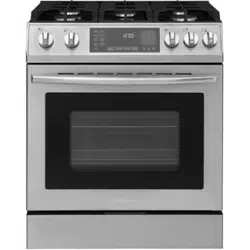Loading ...
Loading ...
Loading ...

www.insigniaproducts.com
10
SURFACE BURNER WARNINGS
Follow basic precautions when installing and using this range to reduce the risk of fire, electrical shock,
injury, or death to persons, including:
Use proper pan sizes. Avoid pans that are unstable or warped. Select cookware having flat bottoms
large enough to cover the burner grates. To avoid spillovers, make sure cookware is large enough to
contain your food. This will save cleaning time and prevent hazardous accumulations of food, since
heavy spattering or spillovers left on the range can ignite. Use pans with handles that can be easily
grasped and remain cool.
Always use the LITE position when igniting the top burners. Make sure the burners have ignited.
Never leave the surface burners unattended at HIGH flame settings. Boil overs cause smoking and
greasy spillovers that might catch on fire.
Adjust the top burner flame size so it does not extend beyond the edge of the cookware. Excessive
flames past cookware edges can be hazardous.
Only use dry pot holders. Pot holders with moisture in them may result in burns from steam when they
come in contact with hot surfaces.
Keep pot holders away from open flames when lifting cookware. Never use a towel or bulky cloth in
place of a pot holder.
Keep all plastic away from the surface burners or any open flame.
When using glass cookware, make sure it is designed for top-of-range cooking.
Always make sure cookware handles are turned to the side or rear of the cooktop, but not over other
surface burners. This will minimize the chance of burns, spillovers, and ignition of flammable materials
due to bumping the pan.
Do not wear loose or hanging garments when using the range. They could ignite and burn you if they
touch a surface burner.
Always heat frying oils slowly, and watch as it heats. If foods are being fried at high heat, carefully watch
during the cooking process. If a combination of fats or oils are to be used during frying, they need to be
stirred together before heating.
Use a deep fryer thermometer whenever possible. This prevents overheating fryer beyond the smoking
point.
Use as little fat as possible for shallow or deep-fat frying. Using too much fat can cause spillovers when
food is added.
Items should always be removed from the cooktop when they are done cooking. Never leave plastic
items on the cooktop. This prevents the hot air from the vent from igniting flammable items, melting, or
building up pressure in closed containers.
This cooktop is not designed to sear foods or cooking with a wok or wok ring attachment. If foods are
flamed, they should only be flamed under a ventilation hood that is on.
Always make sure foods being fried are thawed and dried. Moisture of any kind can cause hot fat to
bubble up and over the sides of the pan.
Never move a pan or deep-fat fryer full of hot fat. It should always be cooled before moving.
If range is located near a window, NEVER hang long curtains or paper blinds on that window. They could
blow over the surface burners and ignite, causing a fire hazard.
Always make sure the controls are OFF and the grates are cool before they are removed to prevent any
possibility of burning.
Grease is flammable and should be handled very carefully. Do not use water on grease fires.
If you smell gas, turn off the gas to the range and call a qualified service technician. NEVER use an open
flame to locate a leak.
Always turn off the surface burner controls before removing cookware. All surface burner controls
should be turned OFF when not cooking.
Do not use a wok on the cooking surface if the wok has a round metal ring that is placed over the burner
grate to support the wok. This ring acts as a heat trap, which may damage the burner grate and burner
head. Also, it causes the burner to work improperly. This may cause a carbon monoxide level above that
allowed by current standards, resulting in a health hazard.
WARNING
Loading ...
Loading ...
Loading ...
